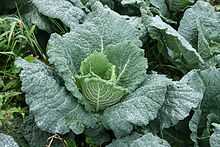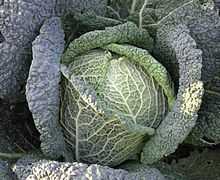Savoy cabbage

 | |
| Nutritional value per 100 g (3.5 oz) | |
|---|---|
| Energy | 113 kJ (27 kcal) |
| Carbohydrates | 6.1 g |
| - Sugars | 2.27 g |
| - Dietary fiber | 3.1 g |
| Fat | 0.1 g |
| Protein | 2 g |
| Vitamin A equiv. | 50 μg (6%) |
| - beta-carotene | 600 μg (6%) |
| - lutein and zeaxanthin | 77 μg |
| Thiamine (vit. B1) | 0.07 mg (6%) |
| Riboflavin (vit. B2) | 0.03 mg (3%) |
| Niacin (vit. B3) | 0.3 mg (2%) |
| Pantothenic acid (B5) | 0.187 mg (4%) |
| Vitamin B6 | 0.19 mg (15%) |
| Folate (vit. B9) | 80 μg (20%) |
| Choline | 12.3 mg (3%) |
| Vitamin C | 31 mg (37%) |
| Vitamin E | 0.17 mg (1%) |
| Vitamin K | 68.8 μg (66%) |
| Calcium | 35 mg (4%) |
| Iron | 0.4 mg (3%) |
| Magnesium | 28 mg (8%) |
| Manganese | 0.18 mg (9%) |
| Phosphorus | 42 mg (6%) |
| Potassium | 230 mg (5%) |
| Zinc | 0.27 mg (3%) |
| Link to USDA Database entry Percentages are roughly approximated using US recommendations for adults. Source: USDA Nutrient Database | |
Savoy cabbage (Brassica oleracea var. sabauda L. or Brassica oleracea Savoy Cabbage Group) is a variety of the plant species Brassica oleracea. Savoy cabbage is a winter vegetable.
Savoy cabbage can be used in a variety of recipes. It pairs well with red wine, apples, spices, horseradish and meat. It can be used for roulades, in stews and soups, as well as roasted plain and drizzled with olive oil.
Cabbage that is heavy for its size with leaves that are unblemished and have a bright, fresh look are signs of desirable quality. Whole cabbages are preferred whenever possible as pre-cut or preshredded cabbage has a greatly diminished vitamin content. Peak season for most cabbages runs from November through April.
Fresh whole cabbage will keep in the refrigerator for one to six weeks depending on type and variety. Hard green, white or red cabbages will keep the longest while the looser Savoy and Chinese varieties need to be consumed more quickly. It is necessary to keep the outer leaves intact without washing when storing since moisture hastens decay.
Cabbage provides fiber, vitamins A, C, K and B6, folate, potassium, manganese, thiamin, calcium, iron and magnesium.
See also
External links
- Brassica oleracea var. sabauda L. at National Center for Biotechnology Information (NCBI)
- Brassica oleracea var. sabauda L., Tropicos.org, Missouri Botanical Garden
![]() Media related to Brassica oleracea var. sabauda at Wikimedia Commons
Media related to Brassica oleracea var. sabauda at Wikimedia Commons